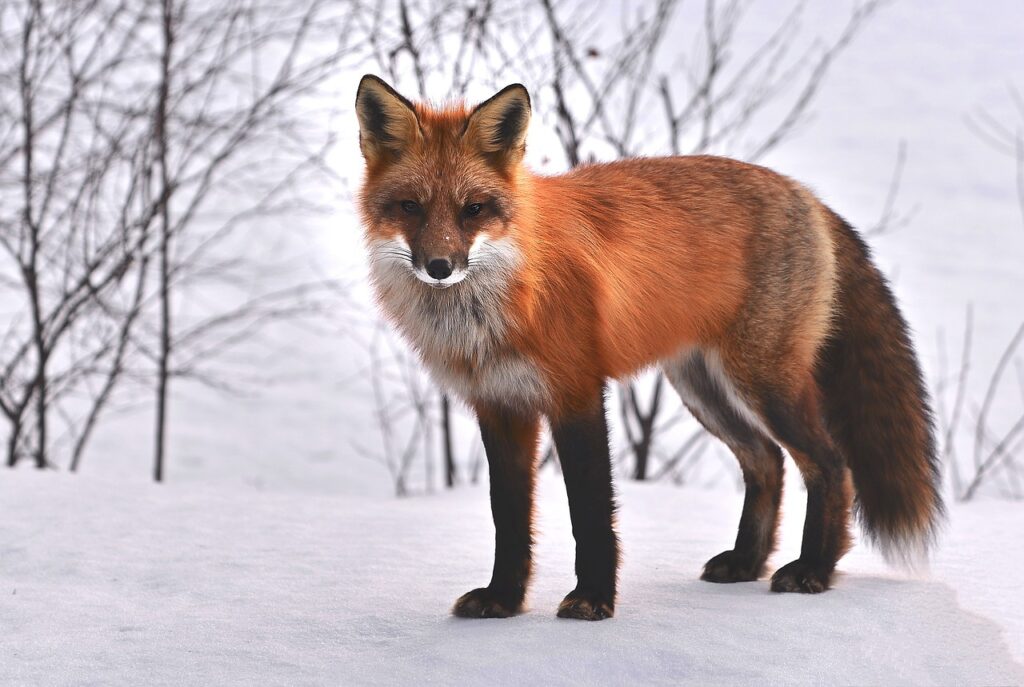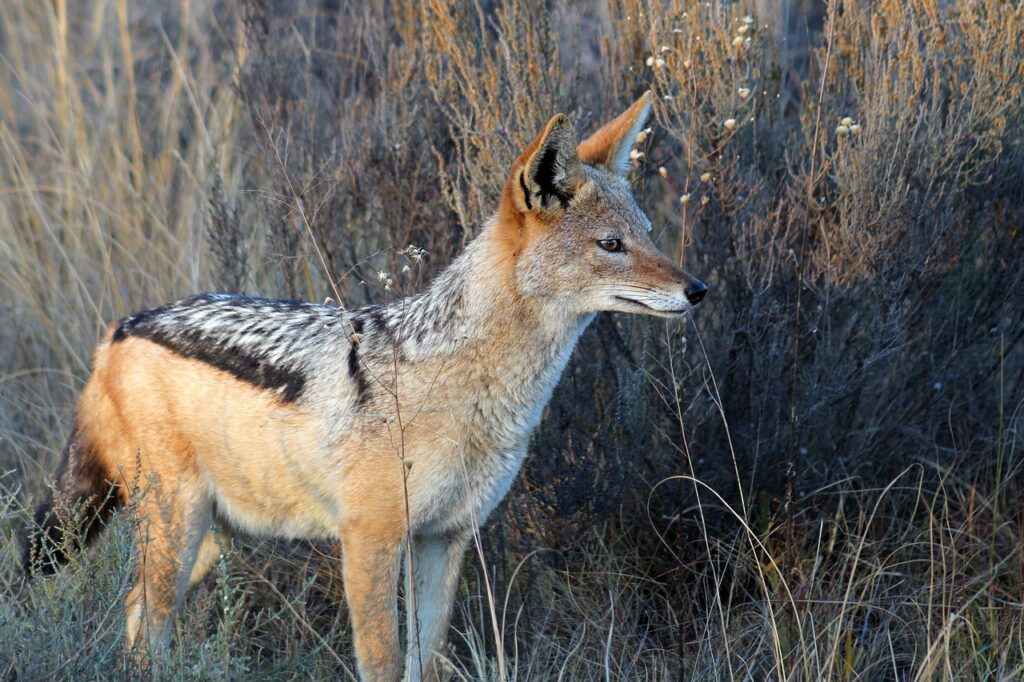FOXES VS JACKALS
Foxes and jackals are two of the more fascinating members of the Canidae family. Both of them are associated with mythological and cultural depictions of the Trickster archetype. Foxes and jackals do not usually capture our imagination whenever we think of canines which are often best represented by wolves and the domestic dog, in some instances. Foxes and Jackals are often thought of as being the same animal.
But foxes and jackals are two distinct animals. Below are some of the more salient differences that separate these two creatures.
WHAT ARE THE DIFFERENCES BETWEEN FOXES AND JACKALS
1. EVOLUTION
Foxes and jackals are generally classified outside of the wolf-like canids. Except for the golden jackal, foxes and jackals diverged from wolves millions of years ago.
There are two extant varieties of jackals: the wolf-like golden jackal ( Canis aureus ) and the smaller jackals of the genus Lupulella. The black-backed jackal and the side-striped jackal are considered to be more ancient species. They are genetically distant from the Canis genus members, including wolves, coyotes, and dogs. There are three existing species under the genus Lupulella.
Foxes are also separate from wolf-like canids. They belong to the genus Vulpes. In terms of evolution, foxes diverged from wolves some 12 million years ago. There are currently 12 extant species of foxes.
2. SIZE AND APPEARANCE
Both foxes and jackals are small to medium-sized animals. But there are some key differences in their physical dimensions.
The fox, in general, ranges from small to medium-sized varieties. A mature male fox, for example, is approximately 78 inches long and weighs around 12 pounds. There is little difference in the size of males and females. Foxes have long and fluffy tails. Large and alert ears and short legs. Another unique physical trait among foxes is that they have whiskers on their faces and legs. This enhances their senses well. Some foxes–the gray fox being a good example–can similarly retract their claws to a cat. Their eyesight is also as good as that of a cat. Their pupils are vertically oriented, just like those of a feline.

A mature male black-backed jackal is about 36 inches long and weighs about 22 pounds. The African varieties ( black-backed jackals and side-striped jackals ) share similar characteristics such as pointed muzzles and snouts, alert ears, and tall gaits. They have longer legs than foxes. Jackals have excellent vision and a sense of hearing. They are capable of detecting the movement of prey underground. They have a smart disposition when they walk.

3. DEPICTION IN MYTH AND FOLKLORE
In American, European, and Asian folklore, the fox is depicted as a mischievous trickster with a very strong connection to magic. Their mischief can range from mere playfulness to something more malevolent. In Asian folklore, the most popular depiction of the fox is that of a nine-tailed magical being. In Japan, fox deities are called “kitsune.” In Korea, they are referred to as “gumiho,” In China, they are “Huli jing.” In these three cultural interpretations, foxes are believed to be shapeshifters who take on the appearance of humans. In Native American and European myths, foxes also appear as shapeshifters who can either be harbingers of either good fortunes or bad omens.
In African mythology, foxes are depicted as tricksters along with the spider. They are also associated with the afterlife in their capacity as spirit guides. In ancient Egypt, Anubis is depicted as the jackal-headed god of death and mummification. The connection between Anubis and the jackal may have been because jackals are commonly observed roaming around graves to feed on decomposing bodies.
4. SOCIAL BEHAVIOR
Foxes are solitary. But they would also roam in pairs, particularly because this is more advantageous in hunting. But foxes also tend to live in groups of 3 to 10, with equal distribution between the dogs ( males ) and the vixens ( females ). When vixens give birth, it usually tends to its litter. But it is also common for foxes to rear all pups in one combined litter.
Jackals generally live in monogamous pairings. They would hunt, rest, and fiercely defend territories as partners. As pairs, jackals are very effective in marking their territories. They do this by marking trails and boundaries with their scents. They also whine and howl distinctly to warn potential intruders or to announce their presence to others.
5. HABITAT
Foxes are native to the American continent, Europe, and Asia. They prefer the cover of forest ecosystems. But foxes can also be found in more open spaces such as grasslands and taigas. They dig dens where they sleep, store provisions, and raise their pups.
Jackals are native to the African continent. All species of jackals prefer open spaces. In Africa, they are found in grassland, savannahs, open woodlands and marshes, and arid desert ecosystems.
6. DIET
Foxes are omnivores. But they are also predators and scavengers. When prey is abundant, they hunt rodents, birds, amphibians, and rabbits. They would also subsist on leftover meat or carrion when the opportunity presents itself. Foxes who live near urban areas will go through trash cans for leftovers or even raid chicken coops. When meat is not readily available, they will eat fruits and berries.
Jackals are primarily hunters. But they can be omnivorous, too, depending on the scarcity or abundance of their preferred prey. Jackal pairs will hunt rats, snakes, and even young antelopes and vultures. They will also steal eggs from nests. They also eat a lot of insects such as beetles, termites, crickets, and grasshoppers. On occasion, they will also eat fruits and berries.
Questions and Answers
HOW DO FOXES AND JACKALS INTERACT WITH HUMAN PRESENCE?
Jackals generally avoid human interactions in the wild, doing so only when their territories are threatened. But with human civilization gradually encroaching into their usual hunting grounds, jackals have adapted well to raiding farms for food. In rural areas in Africa, they have been known to develop a taste for sheep. But they will also target chickens, goats, cats, and dogs. In some rare instances, they might also go after newly birthed calves. The damage they brought upon sheepherders was so immense so that they were considered pests. Fencing properties do little to discourage jackals. They are very intelligent and observant hunters who learn and adapt quickly. Because of their predation, settlers and farmers have hunted them to the point that it became a gentleman’s sport. These hunting excursions are referred to as “jackal coursing” and involve dogs to chase and wear down jackals.
Foxes have also been known to wreak havoc on farms. This is often considered one reason why fox-hunting evolved from being a practical means to trim down their population to a sporting event. Fox-hunting was a favorite pastime among the European nobility and the American elite. Foxes were considered a very challenging quarry because they were very intelligent and physically agile, and fast. This is the reason why foxhounds were bred. Foxhounds were raised for their keen sense of smell, energy, and persistence in tracking and chasing foxes straight to their dens.
There is a fascinating story about the Teumessian fox in Greek mythology, a divinely blessed creature that any living creature could never catch. King Minos took on the impossible challenge of catching the fox by using Laelaps, an equally blessed hound destined to catch anything it chased. The chase went on for days with no resolution in sight since the hound was persistent and tireless, and the fox was elusive. Finally, Zeus decided to end the paradox by casting the fox and the hound to the sky, where they eventually became the constellations Canis Major ( the hound ) and Canis Minor ( the fox )
DO JACKALS COPE WELL IN CAPTIVITY?
Relatively yes. There are historical accounts of jackals being domesticated. But the process of domesticating jackals must begin when they are still pups. With enough time and effort, they can become housebroken like dogs. But unlike dogs, jackals retain their territorial aggression and will react violently to strangers. Domesticated jackals are not used for hunting. In general, they are allowed to roam and feed on decomposing matter. This is considered to be beneficial to the health and well-being of a village or a rural settlement.
DO FOXES COPE WELL IN CAPTIVITY?
Aside from being attractions in zoos, there are historical attempts to domesticate the fox. In ancient times, people tried to tame foxes as pets alongside the first domesticated dogs. They can be tractable when trained patiently. But in general, they are extremely curious, possess great physical energy, and are very loud. They frequently yelp and whine. In the United States, it is illegal to simply adapt a fox as they are considered wild animals that are potential vectors for diseases such as rabies.
CAN FOXES AND JACKALS INTERBREED?
No. They are genetically and geographically distant.

